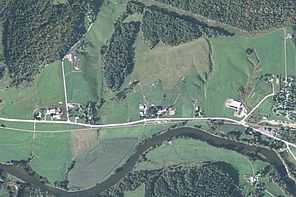Missisquoi Critical Source Area
Late Spring 2012

In 1906, Italian economist Vilfredo Pareto observed that 80% of the wealth in Italy was owned by 20% of the population. Subsequently, the idea that a small number of causes or factors, often in an 80/20 split, can explain a great deal of a system has come to be known as the Pareto Principle. The principle, a common rule of thumb in business management, was recently applied to phosphorus loading in Lake Champlain's Missisquoi Bay. Could a small percentage of the land account for most of the phosphorus pollution loading? A team of consultants funded by the Lake Champlain Basin Program and led by Stone Environmental set out to answer the question.
While the split did not work out exactly 80/20 it was close. Thirty percent of the land accounted for 82% of the phosphorus load. A mere 10% of the land accounted for over 57% of the load according to a watershed model the team put together. These areas of higher pollution loading are referred to as critical source areas, areas that combine a phosphorus source (from soil type or management) with a landscape position that allows the pollution to be delivered to waterways. The landscape position may include hilly terrain where water runs off quickly, proximity to the water, or some combination of factors.
The fact that 65% of the watershed is forest and forests contribute relatively little phosphorus makes their conclusions a little less surprising. However, some forested lands, about 5%, were included as critical source areas. Typically, these were high elevation areas with steep slopes and soils high in organic matter.
Most of the critical source areas were on agricultural lands. In all, the model suggested 64% of the total load came from agricultural lands with land in hay-corn rotation contributing 29% of the total. It is important to note that these pollution loads were not a reflection on putatively good or bad agricultural management; after all the model had to apply a single land-use when in reality farmers rotate crops. Instead, the mere presence of a hay-corn rotation on certain soils with certain slopes generated the load.
Developed lands, including houses and roads, were not prominent in the critical source area model. They accounted for only about 6% of the total phosphorus load. However, developed lands account for only 3% of the land in the Missisquoi watershed.
The three most important factors in determining critical source areas were the lands slope, the soil type, and the likelihood that given soils would become saturated. These factors are not independent of one another. In particular, the likelihood of soil saturation is dependent upon both slope and soil type. Steep slopes and soils that prevent water infiltration such as clays were the most likely to generate phosphorus run-off.
As part of the project, the Stone team compared the efficacy of targeting pollution remediation efforts in critical source areas versus spreading them randomly across the landscape. Not surprisingly, targeted actions produced greater phosphorus reductions than did random actions. However, the percent reduction achieved by targeted actions was actually lower than that achieved by random actions. How can both statements be true? The same way that 20% of ten dollars is less than 10% of one hundred dollars. The results reinforce the idea that best management practices are insufficient for eliminating phosphorus loading from critical source areas.
The greatest utility of the project is in its field by field analysis of the watershed. Agronomists can use the maps and information developed by Stone to target site visits, outreach and various conservation measures to areas where they will achieve the most benefit. In some cases, taking just a small portion of a given field out of production can greatly reduce phosphorus loading.
Though the project focused on identifying areas where phosphorus comes over the land, they also found that stream bank erosion accounted for 40% of the phosphorus entering Missisquoi Bay. That finding has been supported by other recent work in the area. The role of stream bank erosion has been underestimated in most management schemes. There are no programs designed specifically to address bank erosion except in areas where erosion potentially impacts roads, bridges, or other infrastructure. Stream bank erosion can occur independently of present day land use, complicating narratives about what parties or people are responsible for polluting Lake Champlain.
The critical source area analysis conducted by Stone Environmental provides a valuable tool for managing water quality in Lake Champlain's most impaired segment, Missisquoi Bay. A limited version of the analysis might be applied to the broader watershed, but data are simply not available to conduct a similar in-depth analysis everywhere (a significant portion of the $800,000 total project budget went to data acquisition). By no means will the report cure the problems of the bay, but it can help us more efficiently direct the resources we use.
Lake Look is a monthly natural history column produced by the Lake Champlain Committee (LCC). Formed in 1963, LCC is the only bi-state organization solely dedicated to protecting Lake Champlain’s health and accessibility. LCC uses science-based advocacy, education, and collaborative action to protect and restore water quality, safeguard natural habitats, foster stewardship, and ensure recreational access.
Get involved by joining LCC using our website secure form (at www.lakechamplaincommittee.org), or mail your contribution (Lake Champlain Committee, 208 Flynn Avenue - BLDG 3 - STUDIO 3-F, Burlington, VT 05401), or contact us at (802) 658-1414, or lcc@lakechamplaincommittee.org for more information.
